#The Jimmy Durante Show
Audio

This week on Content Abnormal, since it’s Record Store Day, we are presenting a broadcast of The Jimmy Durante Show with special guest star Boris Karloff as “Happy Sam The Record Man”!
Found Sound on Instagram
#record store day#found sound#ferndale mi#ferndale michigan#ray#richard#laura#terry#the jimmy durante show#jimmy durante#boris karloff#happy sam the record man#hazel park library#hazel park michigan#hazel park mi#the vengeance of she#hammer movies#american international#horror#wolfman 1979#jack pierce#lon chaney#lon chaney jr.#wicked darling#todd browning#silent film#mst3k: agent for h.a.r.m.#martin kosleck#robert quarry#count yorga
1 note
·
View note
Text
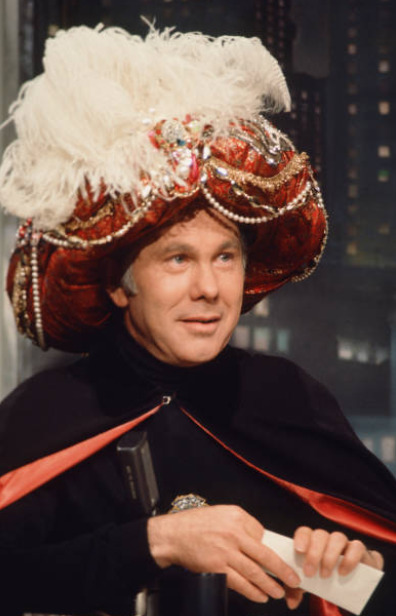
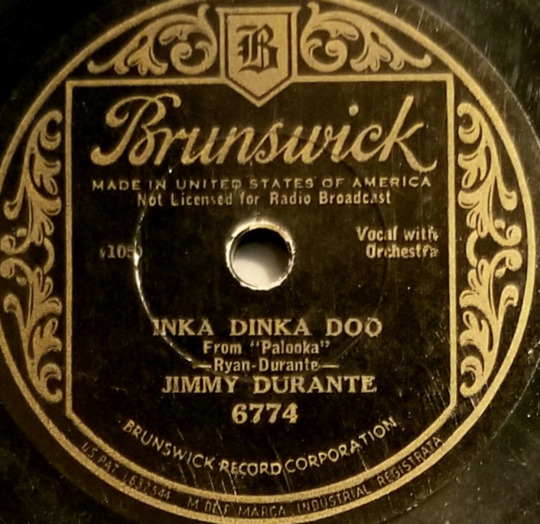
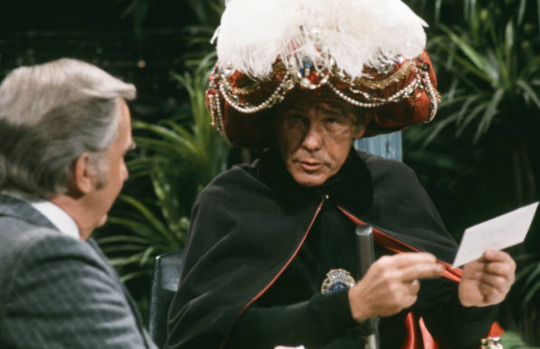
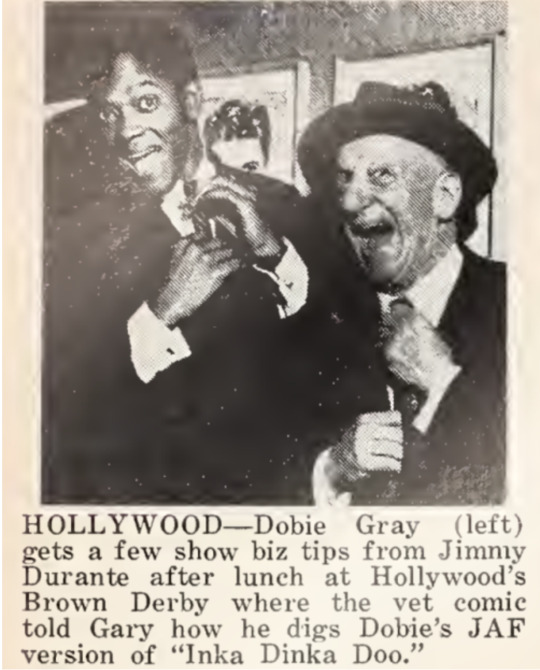
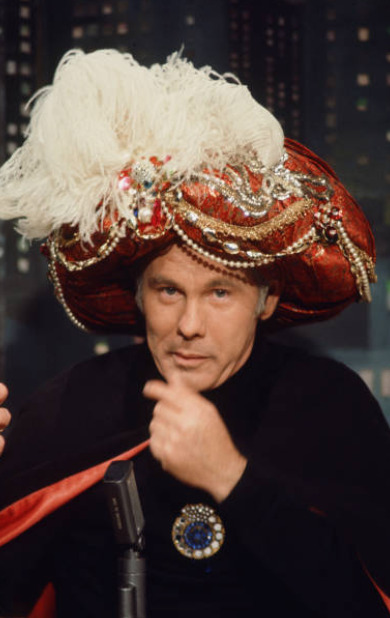
The Tonight Show, July 13, 1977.
Carnac: Inka Dinka Doo.
Ed McMahon: Inka. Dinka. Doo.
Carnac: What gets on your Inka Dinka when you leave it out all night?
15 notes
·
View notes
Text
The Jerry Lewis Show 1963
The Sands Hotel
Las Vegas
aka, the episode I want to see so badly I could cry
WHY IS THIS SHOW NOT FULLY AVAILABLE???
WHY?!?!?!
*incoherent demonic possession level babbling & sobbing ensues*
okay, on with the photos












SOURCE: UNLV library archive
#jerry lewis#the jerry lewis show#1963#the sands hotel#las vegas#ABC#talk show#classic television#sammy davis jr#jimmy durante
16 notes
·
View notes
Text
this is a poll for a movie that doesn't exist.
It is vintage times. The powers that be have decided to again remake the classic vampire novel Dracula for the screen. in an amazing show of inter-studio solidarity, Hollywood’s most elite hotties are up for the starring roles. The producers know whoever they cast will greatly impact the genre, quality, and tone of the finished film, so they are turning to their wisest voices for guidance.
you are the new casting director for this star-studded epic. choose your players wisely.












Previously cast:
Jonathan Harker—Jimmy Stewart
The Old Woman—Martita Hunt
Count Dracula—Gloria Holden
Mina Murray—Setsuko Hara
Lucy Westenra—Judy Garland
The Three Voluptuous Women—Betty Grable, Marilyn Monroe, and Lauren Bacall
Dr. Jack Seward—Vincent Price
Quincey P. Morris—Toshiro Mifune
Arthur Holmwood—Sidney Poitier
R.M. Renfield—Conrad Veidt
The Captain of the Demeter—Omar Sharif
The First Mate of the Demeter—Leonard Nimoy
Edit: adding since there’s been some confusion—this is for MR. SWALES, the old seaman with a bizarre accent in today’s entry of Dracula Daily.
286 notes
·
View notes
Text





Robert Mitchum on the "The Jimmy Durante Show" in 1956.
58 notes
·
View notes
Text
Carmen Miranda - The Brazilian Bombshell
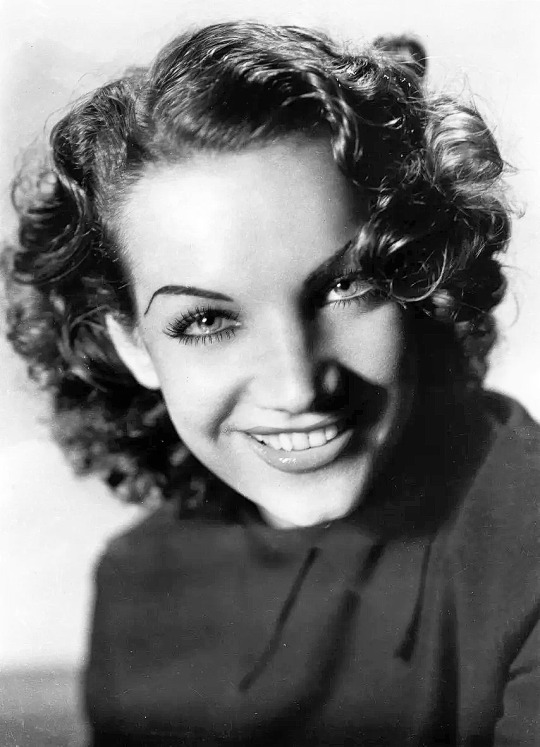
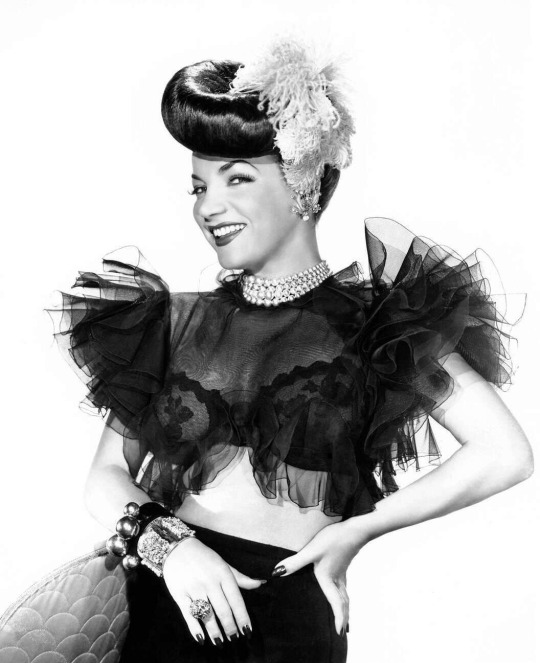


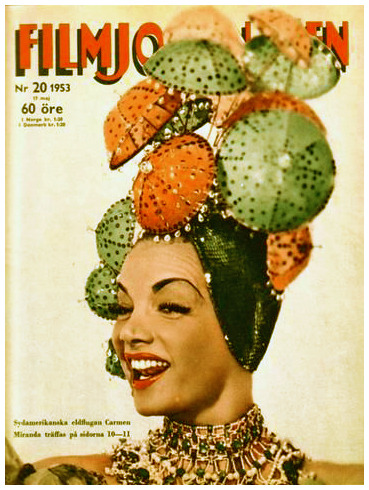
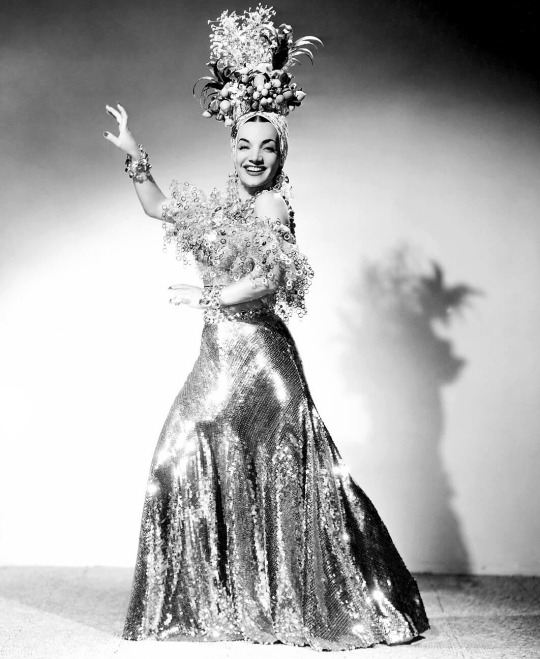
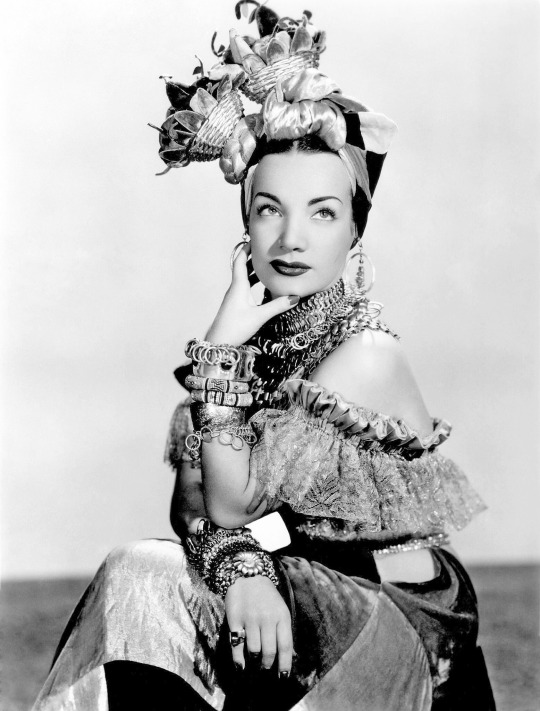
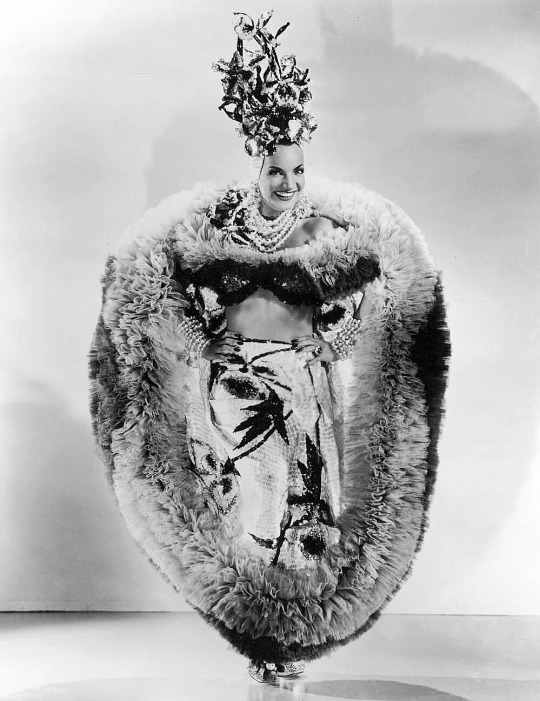
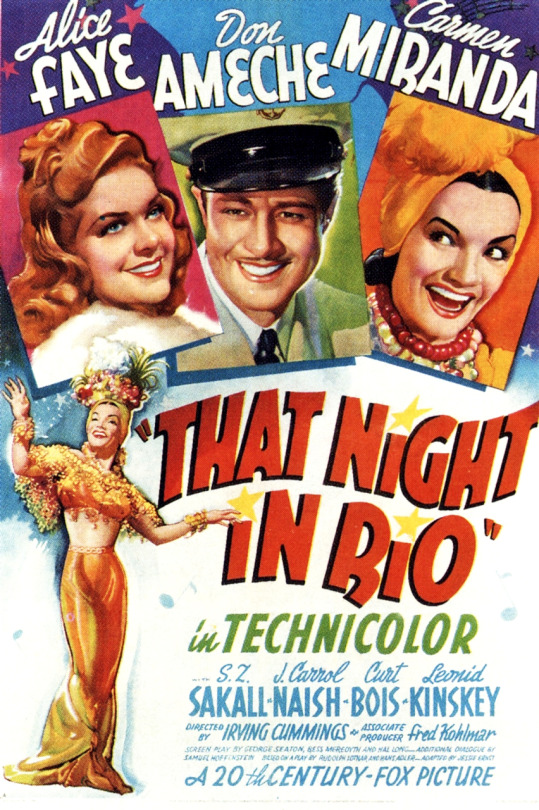



Carmen Miranda (born Maria do Carmo Miranda da Cunha in Marco de Canaveses, Porto on February 9, 1909) was a Portuguese-born Brazilian singer. Nicknamed "The Brazilian Bombshell", she was known for her sass and signature fruit hat outfit that she wore in her American films.
Miranda was introduced to a composer while working at her family's inn, and she soon recorded her first single ("Não vá Simbora") in 1929. She then signed a two-year contract with Rádio Mayrink Veiga, the most popular Brazilian station of the 1930s. Her rise to stardom in Brazil was linked to the growth of a native style of music: the samba.
At the invitation of US show business impresario, Lee Shubert, who saw her perform in Rio's Cassino da Urca, she came to Broadway and starred in hit musicals: The Streets of Paris and Sons o' Fun.
Her fame grew quickly, and she was formally presented to President Franklin D. Roosevelt at a White House banquet shortly after her arrival in the US.
When news of Broadway's latest star (known as the Brazilian Bombshell) reached Hollywood, Twentieth Century-Fox offered her a contract in 1941. Her most memorable film performances are in the musical numbers of films such as Week-End in Havana (1941) and The Gang's All Here (1943).
After World War II, Miranda's films at Fox were produced in black-and-white, indicative of Hollywood's diminishing interest in her. As a result, Miranda decided to produce her own films to limited success. Although her film career was faltering, her musical career remained solid and she was still a popular nightclub attraction. She continued to tour the US, Europe, and Latin America.
After filming a segment for the NBC variety series The Jimmy Durante Show, where complained of feeling unwell, she died at home in Beverly Hills, California from a heart attack. She was 46 years old.
Legacy:
Was the first contract singer in Brazilian radio history; subsequently, the highest-paid radio singer in Brazil in the 1930s
Chosen by former Brazilian president Getúlio Vargas as a goodwill ambassador in the United States in 1939
Was the first Latin American star to have a block in the forecourt of Grauman’s Chinese Theatre in 1941
Was Hollywood's highest-paid entertainer and the top female taxpayer in the US in 1945, earning more than $200,000 that year
Has a museum in Rio de Janeiro, Museu Carmen Miranda, established in her honor in 1976
Received the Ordem do Infante Dom Henrique Grande Oficial, a Portuguese order of knighthood, in 1995
Has a square in Hollywood named Carmen Miranda Square with a ceremony headed by honorary mayor of Hollywood Johnny Grant and attended by Brazilian consul general Jorió Gama in 1998
Was one of 500 stars nominated for the American Film Institute's 50 greatest screen legends in 1999
Honored by the Museum of Modern Art in Rio de Janeiro in 2005 and the Latin America Memorial in São Paulo in 2006 with a Carmen Miranda Forever exhibit to commemorate the 50th anniversary of her death
Bestowed the Ordem do Mérito Cultural by the Ministry of Culture of Brazil in 2009
Was a part of a set of commemorative US Postal Service Latin Music Legends stamps, painted by Rafael Lopez, in 2011
Commemorated in the 2016 Summer Olympics closing ceremony with a tribute
Honored with a Google Doodle on her 108th birthday in 2017
Was the first South American honored with a star on the Hollywood Walk of Fame at 6262 Hollywood Boulevard for motion picture

#Carmen Miranda#The Brazilian Bombshell#Brazilian Bombshell#Samba#Chiquita Banana#Cantora Do It#Ditadora Risonha do Samba#A Pequena Notável#Silent Films#Silent Movies#Silent Era#Silent Film Stars#Golden Age of Hollywood#Classic Hollywood#Film Classics#Classic Films#Old Hollywood#Vintage Hollywood#Hollywood#Movie Star#Hollywood Walk of Fame#Walk of Fame#Movie Legends#Actress#hollywood actresses#hollywood icons#hollywood legend#movie stars#1900s
35 notes
·
View notes
Text
This Day in Buster…August 13, 1932
Buster Keaton shows how to outdo Jimmy Durante in just one minute- it got Ed Brophy laughing. "Speak Easily" opens in the U.S.
#this day in buster#buster keaton#jimmy durante#ed brophy#1930s#speak easily#talkies#mgm#vintage hollywood#ibks#the international buster keaton society#buster keaton society#the damfinos#damfino#damfamily
19 notes
·
View notes
Text
youtube
You ever think about how many times you watched Looney Tunes as a kid and though "Why does this weirdly specific fucked up looking guy keep showing up?" only to find out years later it was just a recurring caricature of a very specific celebrity who we all just kinda collectively culturally forgot about.
See also: Peter Lorre, Jimmy Durante, Ed Wynne
#history is a foreign country#looney tunes#jerry colonna#celebrities#celebrity caricatures#silly#weird
16 notes
·
View notes
Text
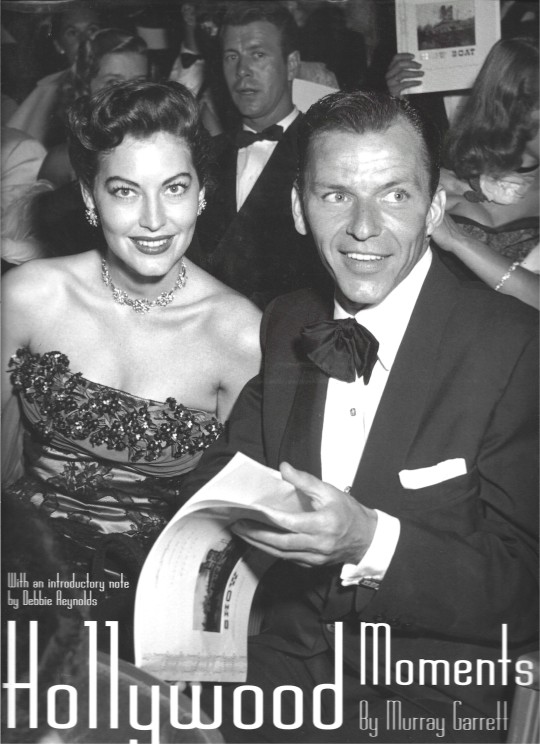
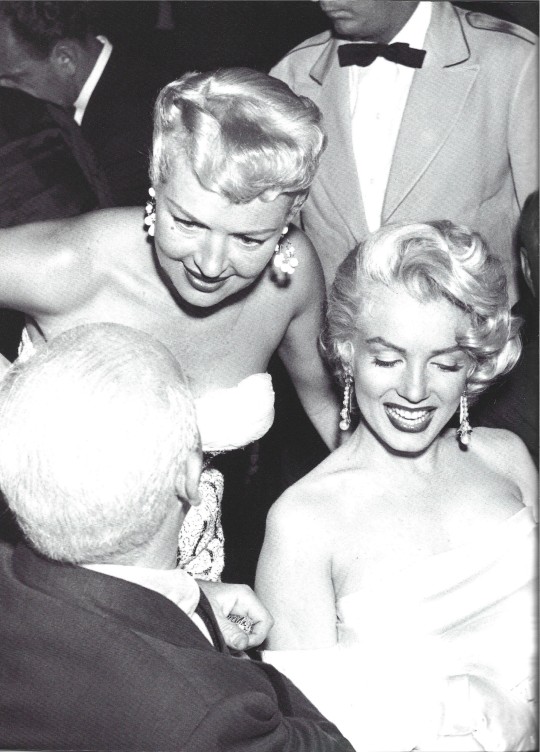



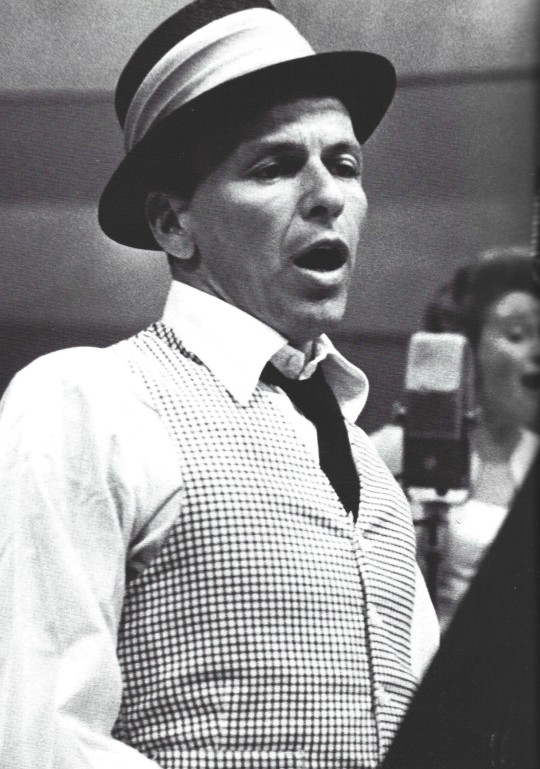
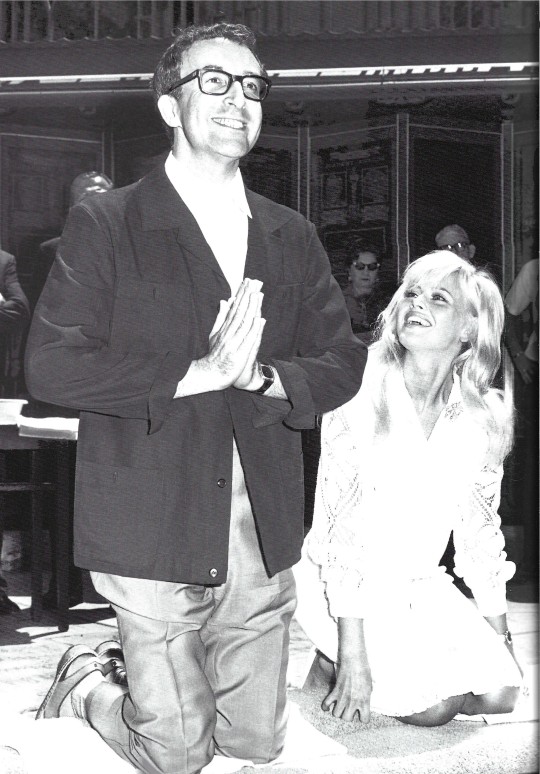


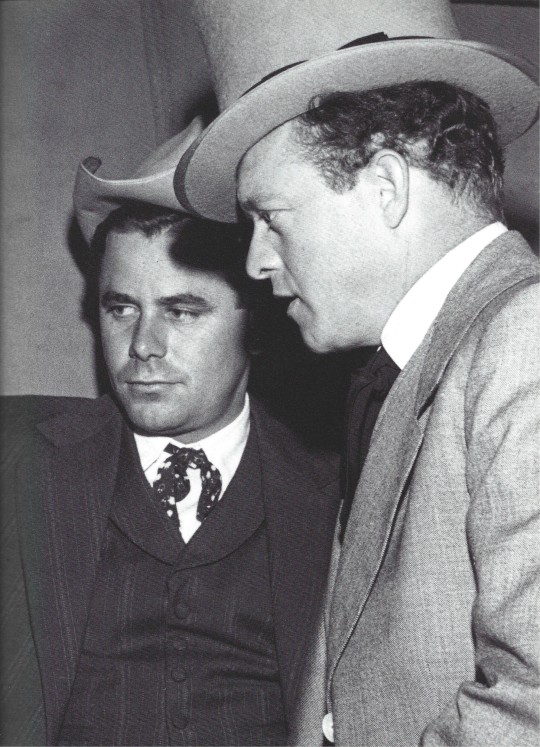

Hollywood Moments
By Murray Garrett
With an introductory note by Debbie Reynolds
Abrams, New York 2002, 178 pages, 24x30,5cm, 145 duotone photographa, ISBN 978-0810932425
euro 80,00
A follow-up to Hollywood Candid showcases 145 images of stars taken during intimate or irreverent moments, in a volume containing many never-before-seen photos and complemented by personal reminiscences.
he pathos of Old Hollywood emerges in this dazzling collection of black-and-white photos from the 40s, 50s and 60s. Celebrity photojournalist Garrett captured his subjects at nightclubs, industry soirées and parties-an in-between world where stars tried to enjoy their private lives while still very much on public display. Garrett maintained a studied reserve toward the celebrities (he made a point of never addressing them by their first names) and his photos have a appealing mixture of intimacy and detachment as the celebrities drink, laugh and carouse while tricked out in formal wear and immaculate hair-dos. He is especially fascinated with Hollywood divas like Elizabeth Taylor, Marilyn Monroe, Leslie Caron and Ava Gardner; his photos show the warmth of these vibrant personalities while hinting at the strain they suffered in maintaining their glamorous facades. The photos are accompanied by piquant reminiscences: of the wise-cracking Zsa-zsa Gabor shoving her way into every picture frame, the lovable Jimmy Durante shoving his way into oncoming traffic, and the thuggish Milton Berle shoving hapless underlings out of his dressing room. In one tense picture worth a thousand words, a vampy Lauren Bacall embraces Van Heflin while her husband, Humphrey Bogart, looks on ("I heard Bogey say, in a chilled tone, 'Van, that's close enough'"). In these lively, unlacquered but sympathetic portraits, celebrities emerge as flawed, human and never entirely free of self-consciousness.
17/10/23
#hollywood Moments#candid showcases#145 images#40s 50s 60s images#Elizabeth Taylor#Marilyn Monroe#Leslie Caron#Ava Gardner#Laureen Bacall#Humphrey Bogart#photography books#fashion books#fashionbooksmilano
42 notes
·
View notes
Note
Hi there, do you have any special memories from this holiday season that you would like to share?
From THIS holiday season? Oh, no. I am in full-on isolation mode.
I have started watching all of the Rankin/Bass Christmas specials. So far I have watched:
-Rudolph the Red-Nosed Reindeer (1964) (Burl Ives)
-Cricket on the Hearth (1967) (Danny Thomas & Roddy McDowall)
-The Little Drummer Boy (1968) (Greer Garson)
-Frosty the Snowman (1969) (Jimmy Durante)
-Santa Claus is Comin' to Town (1970) (Fred Astaire & Mickey Rooney)
-'Twas the Night Before Christmas (1974) (Joel Grey)
-The Year Without a Santa Claus (1974) (Mickey Rooney and Shirley Booth) (This is the one with Heat Miser & Snow Miser.)
-The First Christmas: The Story of the First Christmas Snow (1975) (Angela Lansbury)
And I have 11 more to go!
I did host my family's Thanksgiving at my house. That was more work than I expected. I did absolutely nothing the day after. Then that Saturday I put-up the decorations outside the house. And on that Sunday I put up the tree inside the house.
Today I finally got down the other boxes of decorations for inside the house and will work on it this evening before the kids come tomorrow.
Last week I visited a friend in Palm Springs for his birthday. That took a lot out of me. Work was madness AND I was working from his apartment. All of my energy was spent ensuring he had a good birthday and staying on top of work. By the time the weekend came, I was exhausted and did nothing.
I will be visiting a friend in Long Beach sometime this month. He will be in Puerto Vallarta next week, so probably the week after that.
But no, I have no other plans. I'm not going to our company's Christmas party. I am not doing the annual Christmas show at our local theater. I have no events scheduled to appear as Santa.
I am isolating and keeping to myself for the most part this holiday season.
And that's it for special memories this holiday season. Sorry. I'm not sure what's going on with me. It's been a weird year. I've been in monk-mode since spring, not going anywhere or seeing anyone.
12 notes
·
View notes
Text
LÉGENDES DU JAZZ
DON BYRON, AGENT PROVOCATEUR
"Nobody calls up Eric Clapton and says, 'Yo, Clapton, you're the white guy that plays all that black {expletive}, right? Why don't you come play at a rally?' What makes them think they can do that to me?"
- Don Byron
Né le 8 novembre 1958 à New York, Donald Byron était issu d’une famille musicale. Son père, Donald Byron Sr., était postier et jouait de la contrebasse dans des groupes de calypso. Sa mère Daisy White travaillait comme téléphoniste et était aussi pianiste. Sous l’influence de sa mère, Byron avait été initié à une musique diversifiée allant de la musique classique à la salsa et au jazz. Exposé à la musique de Dizzy Gillespie, du percussionniste cubain Machito et de Miles Davis durant ja jeunesse, Byron avait également assisté à des spectacles de ballet et de musique classique.
Même si le fait d’avoir été familiarisé avec une musique aussi éclectique l’avait aidé Byron à bâtir un style très personnel, il n’avait pas toujours pu exploiter tout son potentiel en raison de ses origines afro-américaines. Il expliquait: "Nobody wanted to believe I was capable of doing the classical stuff. I'd show up and they'd say, 'You want to play jazz.' In the classical pedagogy, I had teachers telling me my lips were too big."
Byron ayant été atteint d’asthme durant son enfance, un médecin lui avait recommandé d’apprendre à jouer d’un instrument à vent afin de développer ses capacités respiratoires. C’est ainsi qu’il avait commencé à jouer de la clarinette.
Byron avait grandi dans le sud du Bronx aux côtés de jeunes juifs qui avaient contribué à développé son intérêt pour le klezmer, la tradition musicale des Juifs ashkénazes d’Europe centrale et d’Europe de l’Est. Décrivant son intérêt pour la musique juive, Byron avait commenté: ‘’I was playing Jewish music 15 years before all of this downtown [radical Jewish culture] activity. [Klezmer] is just a music that uses clarinet; it’s just one of the musics that I play that uses clarinet. I was interested in the chord changes and the scales. There’s lots of little musics around the world where the clarinet is kind of like the lead instrument.”
Parmi les autres influences de Byron à cette époque, on remarquait Joe Henderson, Artie Shaw, Jimmy Hamilton et Tony Scott. À l’adolescence, Byron avait pris des cours de clarinette avec Joe Allard. Il avait aussi écrit des arrangements pour le groupe de son high school. George Russell avait également été un de ses professeurs durant ses études au New England Conservatory of Music de Boston où il avait décroché un baccalauréat en musique en 1984. Durant cette période, Byron avait également fait partie du Klezmer Conservatory Band dirigé par Hankus Netsky. À l’époque où il avait obtenu son diplome, Byron était d’ailleurs devenu le leader du groupe. Il avait aussi joué avec des groupes de jazz latin. Byron avait également étudié à la Manhattan School of Music de l’Université de New York.
DÉBUTS DE CARRIÈRE
Byron avait quitté le Klezmer Conservatory Band en 1987 pour travailler avec de grands noms du jazz comme Reggie Workman, Hamiet Bluiett et Bill Frisell. Il avait aussi joué avec des musiciens d’avant-garde comme Craig Harris et David Murray.
En 1991, Byron avait publié un premier album comme leader intitulé Tuskegee Experiments. Le titre de l’album faisait référence à une série d’expériences médicales et psychologiques hautement discutables sur le plan éthique tentées sur des Afro-Américains en 1932. Enregistré avec Frisell et Workman, l’album comprenait des versions de "Auf Einer Burg" du compositeur classique Robert Schumann et de ‘’Mainstem’’ de Duke Ellington. Le Penguin Guide to Jazz avait qualifié l’album de chef-d’oeuvre et d’un ‘’des premiers albums les plus excitants en plus d’une décennie."
L’album suivant de Byron, Plays the Music of Mickey Katz, avait été une surprise pour les amateurs de jazz qui ne connaissaient pas les antécédents de Byron avec la musique klezmer. Tentative de témoigner de la contribution des traditions yiddish à la culture populaire américaine, l’album avait été décrit en ces termes par Byron qui avait expliqué en entrevue: "People today think that Jewish musicians of the 20's, the generation that could have been klezmers, had the greatest attitude about their own music. But really, those cats didn't want to know... klezmer. They wanted to play jazz or symphony --anything to avoid being stereotyped by klezmer." Malheureusement, plutôt que de mieux faire accepter la culture yiddish, l’album avait eu pour résultat de l’enfermer dans certains stéréotypes. Comme Byron l’avait expliqué plus tard au cours d’une entrevue accordée au magazine Down Beat: "I run into people all the time who don't know I made anything after the Mickey Katz record. No matter how much I've done before and after, it always seems to be that stuff they want to talk about and hear. Sometimes I'm sorry I did it."
ÉVOLUTION RÉCENTE
Peu avant la publication de l’album Music for Six Musicians en 1995, Byron avait expliqué la démarcation qui existait entre le jazz dit ‘’mainstream’’ et l’avant-garde. Comme il l’avait déclaré au cours d’une entrevue accordée au magazine New York Times:
"Me and most of the cats I hang with, we're too left-wing to be around {mainstream jazz institution Jazz At} Lincoln Center. They should be presenting the freshest, baddest stuff. I don't even exist in jazz the way these people perceive it to be.... I've gotten to the point where I can't care what other jazz cats think." L’album Music for Six Musicians était un hommage à la musique afro-cubaine qui avait marqué la jeunesse de Byron dans le Bronx. La musique latine formait d’ailleurs un volet important de la personnalité musicale de Byron. Continuant de témoigner d’une grande conscience sociale, Byron avait ouvert l’album sur un extrait du poème d’Haji Sadiq Al Sadiq "White History Month," qui contenait des affirmations comme: "You think it fair if there was a white history month? ... I picture a kind of underground railroad, Delivering us in the dead of night from the inner city to the suburbs, Yea, like right into the hands of the Klan?"
En 1996, Byron avait fait une apparition dans le film Kansas City de Robert Altman aux côtés d’autres grands noms du jazz comme Geri Allen et James Carter. Même si le film était un hommage à la musique du début au milieu des années 1930, la bande sonore avait laissé une grande place au jazz contemporain. Selon le directeur musical Hal Willner, "If you listen to records like 'Lafayette' {by Count Basie} or 'Prince of Wails', there was as much energy as any punk-rock I've ever heard." Dans le film, Byron avait interprété un solo sur la pièce d’Eddie Durham "Pagin' the Blues."
En 1996, Byron avait d’ailleurs publié un album intitulé Bug Music dans lequel il avait rendu hommage à la fois aux compositions classiques de Duke Ellington et aux oeuvres des compositeurs John Kirby et Raymond Scott, qui avaient souvent été discrédités par les critiques malgré leur succès commercial et la complexité technique de leur musique. Comme Byron l’avait expliqué dans l’ouvrage Music and The Arts, "Even in Gunther Schuller's The Swing Era, {he says} it's not really good music.... When you look at the era those cats came up in, that was the stuff that was turning everybody out." Byron avait ajouté que le titre de l’album était inspiré d’un épisode du dessin animé The Flintstones qui comprenait une parodie des Beatles avant que la musique du groupe ne soit considérée comme acceptable par les critiques de la musique ‘’mainstream.’’
En suivant sa propre inspiration et en ignorant les préjugés subjectifs des critiques, Byron était devenu une des voix les plus intéressantes de la musique des années 1990. Dénonçant la façon stéréotypée dont les musiciens noirs étaient traités dans le cadre d’un profil publié dans le magazine New York Times, Byron avait déclaré: "Nobody calls up Eric Clapton and says, 'Yo, Clapton, you're the white guy that plays all that black {expletive}, right? Why don't you come play at a rally?' What makes them think they can do that to me?"
En 1999, lors de la promotion de son album Romance With the Unseen, Byron avait expliqué pourquoi il avait toujours eu des goûts aussi éclectiques. Byron, qui détestait les étiquettes, avait commenté:
‘’I think lots of people listen to that range of music. Ultimately, intellectually, I’m very connected to that range of idioms. The clarinet puts you in a situation that’s kind of unique. There’s no way you can play the clarinet without playing classical music, so well all have that, even some of the cats like Greg Tardy. To play as much clarinet as he plays, you can’t without going to school and studying Mozart. People are just not used to seeing black folks to do that. It just takes that involvement in that kind of music to get to a point where you can even finger some jazz.’’
Byron croyait d’ailleurs que sa jeunesse dans le Bronx l’avait préparé à manifester une grande ouverture face aux autres cultures. Il expliquait:
‘’In terms of trying to put together a poetry project {Nu Blaxploitation}, I grew up in the South Bronx (Eddie Daniels didn’t grow up in the South Bronx) so I saw Grandmaster Flash and DJ Cool Herc; these cats were all around the neighborhood, so I witnessed the beginning of {hip-hop}. My parents are of Afro-Carribean descent so we were into the calypso, and Afro-Carribean stuff and Cumbia... and my father was a jazz musician too, so we even knew some cats who were in and out of the Basie and Ellington bands. So I’m not really doing anything that I didn’t hear before I was 18. I didn’t grow up in a sheltered way, like I didn’t hear before I was 18. I didn’t grow up in a sheletered way, like ‘We’re from the Dominican Republic and we only listen to meringue’’; that’s not the way I grew up.’’
Évoquant son implication sociale et politique, Byron avait déclaré:
‘’I just have a certain politic. I think a lots of people have a polioc, but I think in the past, certainly since the Young Lions era, there hasn’t been a lot of politics in the music. But compared to what Mingus was talking about it’s not excessive, compared to what the hip hop cats are talking about, or the Last Poets, I don’t think it’s excessive. People that know me know what if we’re gonna talk for an hour, we’ll spend 20 minutes talking about stuff that I have in my pieces. When I think about putting that politic and that feeling in the music I think back to the Gary Bartz Ntu Troop. That for me was a model of how to do it, just feeling ike when you put out a thing you want to put out some kind of gestalt picture of what you are. I think we’re at a point in history where people don’t want to think about those things because it profits them to think, or at east to let you think, that all of this stuff is over and we don’t need to be talking about biases of race and gender. And it’s never over, either you want to talk about it or you don’t, so if the fact that you want to talk about it means that you’re controversial. If you read where I was coming from doing the Mickey Katz and doing Bug Music, there’s even a politic to those particular projects.’’
Membre de la Black Rock Coalition, une organisation qui affirmait que le rock n’ roll était inspiré de la musique noire, Byron avait interprété la pièce "Bli Blip" dans la compilation de la Red Hot Organization intitulée Red Hot + Indigo en 2001. Hommage à la musique de Duke Ellington, l’album avait pour but de recueillir des fonds pour prévenir et combattre le SIDA. Dans le cadre de l’album, Byron avait joué aux côtés de Bill Frisell, Joe Henry, Marc Ribot, Vernon Reid et Allen Toussaint. Dans les années 1990, Byron avait également dirigé le quintet de musique classique Semaphore. De 1996 à 1999, Byron avait aussi été directeur musical de la Brooklyn Academy of Music où il avait dirigé une série de concerts pour le Next Wave Festival et présenté en première son spectacle pour enfants intitulé Bug Music for Juniors.
De 2000 à 2005, Byron avait été artiste-en-résidence au New York's Symphony Space où il avait dirigé l’Adventurers Orchestra, lancé la série de concerts Contrasting Brilliance et tranmis sa vision de compositeurs et d’artistes comme Henry Mancini, Sly Stone, la compagnie de hip-hop Sugar Hill Records, Igor Stravinsky, Raymond Scott, Herb Alpert et le groupe Earth, Wind and Fire.
Également professeur, Byron avait enseigné la composition, l’improvisation, l’histoire de la musique, la clarinette et le saxophone à la Metropolitan State University of Denver (2015), l'Université d'Albany (2005–2009) et le Massachusetts Institute of Technologie (MIT) de 2007 à 2008. Historien du jazz reconnu, Byron avait tenté de recréer dans ses albums des moments importants de l’histoire des de la musique populaire, notamment dans le cadre d’albums comme Plays the Music of Mickey Katz (1993) et Bug Music (1996).
Don Byron a remporté de nombreux honneurs au cours de sa carrière, dont une bourse de la Fondation Guggenheim en 2007. La même année, Byron avait été nommé USA Prudential Fellow et avait décroché une bourse de United States Artists, une organisation caritative qui soutient et encourage le travail des artistes américains. En 2009, l’American Academy de Rome lui avait également décerné un Rome Prize Fellowship. La même année, la composition de Byron intitulée Seven Etudes for solo piano, qui lui avait été commandée par la pianiste Lisa Moore, lui avait valu d’être mis en nomination pour un prix Pulitzer en composition. Byron avait aussi été mis en nomination en 2005 pour un prix Grammy pour le meilleur solo de jazz instrumental pour son solo de clarinette basse sur le standard "I Want to Be Happy" tirée de l’album Ivey-Divey en 2004. Byron avait également été juge lors du 2e gala des Independent Music Awards. Élu artiste de jazz de l’année par le magazine Down Beat en 1992, Byron avait également remporté le prix de meilleur clarinettiste dans le cadre des sondages des critiques du magazine Down Beat de 1992 à 1997.
Musicien et compositeur très éclectique, Byron a travaillé dans des contextes diversifiés allant de la musique classique à la salsa, en passant par le be bop, le swing, le hip-hop, le funk, le rhythm & blues et la musique klezmer. Il s’est également produit dans plusieurs festivals de musique à travers le monde, y compris à Vienne en Autriche, San Francisco, Hong Kong, Londres en Angleterre, Monterey en Californie, en Nouvelle-Zélande et à Broadway.
Byron a collaboré avec les plus grands noms du jazz au cours de sa carrière, de Mario Bauza au Duke Ellington Orchestra, en passant par John Hicks, Tom Cora, Bill Frisell, Vernon Reid, Marc Ribot, Cassandra Wilson, Hamiet Bluiett, Anthony Braxton, Geri Allen, Jack DeJohnette, Hal Willner, Marilyn Crispell, Reggie Workman, Craig Harris, David Murray, Leroy Jenkins, Bobby Previte, Gerry Hemingway, DD Jackson, Douglas Ewart, Brandon Ross, Ed Neumeister, Tom Pierson, Steve Coleman, Living Colour, Ralph Peterson, Uri Caine, Mandy Patinkin, Steve Lacy, les Kansas City All-Stars, les Bang On A Can All-Stars, Medeski Martin & Wood, Angelique Kidjo, Carole King, Daniel Barenboim et Salif Keita. Il a également collaboré avec l’Atlanta Symphony, Klangforum Wien (un orchestre de chambre autrichien), le guitariste auteur-compositeur Joe Henry, l’écrivain Paul Auster, la poète, bassiste et autrice-compositrice Meshell Ndegeocello et plusieurs autres.
Évoquant sa collaboration avec Jack DeJohnette, Byron avait expliqué: ‘’I like those loud, interactive drummers, all of which are coming out of Jack, even Joey Baron and Ralph Peterson - they’d all say in a heartbeat that they’re coming out of {Jack}. So it was just interesting to experience Jack firsthand.’’ Au sujet de sa collaboration de longue date avec le guitariste Bill Frisell, Byron avait ajouté: ‘’We have a sense of line that’s similar and a sense of harmony and how to attack it. I think that we’ve used all of the indefinite qualities of our instruments together in a really kind of unusual way.’’
Un des derniers projets de Byron était un duo avec le pianiste Uri Caine. Il expliquait:
‘’I’m doing this duo thing, gathering songs together that have the kind of control over harmony and the drama of lyrics that an aria from an opera has. I had to try to find some stuff that did that. There’s the obvious stuff, like the Schumann that I love, Puccini, but then I pulled in some Stevie Wonder or some L.A. and Babyface, and we’re gonna have different singers come in and guest. It’s a duo between me and Uri with a few guest singers, some Broadway, some pop, some jazz.’’
Grand amateur de musique classique, Byron appréciait particulièrement la Symphonie No 1 de John Corigliano. Il expliquait: ‘’An excellente performance, great music that actually encourages classical players to make improvisational choices without they knowing it.’’ Parmi ses autres albums de prédilection, Byron citait La Sonora Poncena, un disque de jazz afro-cubain dEdward Simon la Bikina, Musical Conquest de Mike Nichols et Elaine May et Sonny Meets Hawk, de Sonny Rollins et Coleman Hawkins.
©-2024, tous droits réservés, Les Productions de l’Imaginaire historique
SOURCES:
‘’Don Byron.’’ Wikipedia, 2023.
‘’Don Byron.’’ All About Jazz, 2023.
‘’Don Byron Biography.’’ Net Industries, 2023.
JENKINS, Williard. ‘’Don Byron: Range and Vision.’’ Jazz Times, 25 avril 2019.
2 notes
·
View notes
Text
50 CELEBRITIES YOU (MAYBE) DIDN'T KNOW HAD TIES TO PRO WRESTLING
Even before Mr. T got involved in the first Wrestlemania, celebrities of one form or another have been stepping into the squared circle. A list of those well-known famous folks appearing just on WWE shows over the decades would be near-infinitely long, let alone once you add the ones that showed up in WCW, ECW, IMPACT and, now, AEW. But this list/article, which I first started putting together over five years ago, is an attempt to go beyond the more mainstream publicity stunts. With only a couple of exceptions, this list is going to be a little different, covering 50 of the movie stars, athletes and even politicians who appeared outside of those notable promotions. Now, in fairness, some on the list were wrestlers first and foremost, but I feel their connections with popular culture outside of the squared circle qualifies them for such a list. And now, the list:
50. BELA LUGOSI

Kicking things off is Dracula himself. One of the earliest examples of a celebrity taking part in a wrestling show, Bela Lugosi appeared on one show managing/seconding NWA legend Lou Thesz. While this may sound unreal considering Thesz' stance on theatrics in wrestling, Lou himself verified it on his old message board. It was essentially a publicity stunt (as all these things are, honestly) arranged by Sandor Szabo, as all three men with ties to Hungary had been acquaintances prior. Sadly, beyond Thesz confirming it happened, little else of the match and event have surfaced; no date, venue or opponent (possibly Szabo?) is known, nor is whether or not Bela wore his famous Dracula cape to the ring.
49. KIWI KINGSTON

Lugosi wasn't the only Universal Monster to get involved with pro wrestling. Unlike Bela, New Zealand-born Erine "Kiwi" Kingston was a wrestler first - with a 20+ year career stretching back to the late 1940s. - but his turn as the Frankenstein Monster in the Hammer/Universal co-production THE EVIL OF FRANKENSTEIN (1964) late in his career is undoubtedly what he is most well-known for today. He would have two more unremarkable cinematic outings and wrap up his wrestling career by 1969. He may not have been the most well-known Frankenstein Monster in either the Hammer or Universal series, he is technically the final Universal one, so that counts for something.
48. MAX PALMER

One of the legit giants of the wrestling ring, Max Palmer's billed height ranged anywhere between 7'7" and 8'2 While neither is likely accurate, he was still a tall, tall boy. Palmer originally took his massive frame to Hollywood, but only managed to snag a handful of (known) roles while there. Mostly used for sight gags on comedy shows starring the likes of Martin & Lewis as well as Jimmy Durante, Palmer would become somewhat iconic as one of the more prominent Martians in INVADERS FROM MARS (1953).

Palmer was also the titular monster in the B-movie KILLER APE (1953), sparring with Johnny (Tarzan) Weissmuller's Jungle Jim. Leaving Tinseltown behind, Palmer would soon find another calling in the squared circle. Originally billed under his real name, he would soon alternate between it and Paul Bunyan (and later, a third gimmick - Hercules) as he worked territories across the country, including (what would eventually be known as) Mid-Atlantic, CWF, AWA and Tri-State/Mid-South often taking part in battle royals and 2-or3-on-1 matches, but also working with the likes of Verne Gagne, Bobo Brazil, Dory Funk and Angelo Poffo. While it lasted longer than his acting stint, wrestling was also not Max's ultimate calling; he would retire from the ring after only five years. After that, he became an evangelist billing himself as Goliath For Christ. Most of us just know him as a classic movie monster.
47. TOR JOHNSON

An icon to bad movie buffs everywhere, Tor Johnson's wrestling career isn't *that* big a secret, especially if you watched Tim Burton's ED WOOD (1994). However, I'm a petty bastard and I want to use this as a platform to set one of that lovely film's many, many factual errors straight. While the movie shows the inept director discovering the brutish Johnson at a wrestling show and convincing him to be in a movie, the truth is Johnson's acting career (and to a degree, his wrestling career) were much more robust than Burton's take on things. In truth, by the time Wood and Johnson met, Tor had not only been wrestling for 23 years, but had been acting for 21 of them as well. With over two dozen film credits to his, er, credit prior to the Wood films, Tor had appeared (albeit often uncredited) in the films of W.C. Fields, Erroll Flynn, Abbott and Costello, and Bob Hope. His rasslin' career was nothing to sneeze at, either, with Buddy Rogers being the wrestler Tor worked with the most during his career. Very little of his actual ring work exists (the image used above is from a movie in which he portrayed a wrestler), which is a shame, but how many wrestlers can say they were a Don Post mask?
46. HAROLD SAKATA
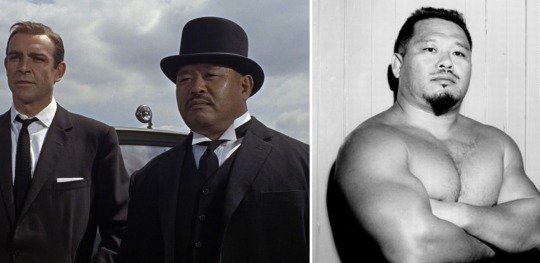
Since we're kind of in the "actual wrestlers, just more well-known for some one-off in Hollywood" zone, let's continue with one of the most famous examples. First gaining some amount of fame winning a silver medal in weightlifting for the U.S. at the 1948 Olympics, Sakata began a wrestling career that would span nearly 30 years, working under his own name and as Tosh Togo. During that time, he traveled the world, worked over 2000 matches on record, feuded with the likes of Nick Bockwinkel and helped introduce Rikidozan to the business during a tour of Japan. In 1964, Sakata was cast in his first acting gig as the villainous henchman Oddjob in the James Bond film GOLDFINGER (1964). The film proved a massive hit, eventually amassing $124 million off a $3 million budget. With his sudden demand in Hollywood, Sakata would lighten his grappling schedule over the years as he took on more roles; while most of the films he appeared in were most of the B-movie nature, he fared better on television, where his instantly-recognizable appearance saw him cast in everything from the ROCKFORD FILES to GILLIGAN'S ISLAND. A memorable parody of Sakata's Oddjob would appear decades later in the first AUSTIN POWERS film, proving this great wrestler's legacy in the cinematic world doesn't look too shabby, either.
45. MACH FUMIAKE

Mach Fumiake (born Fumie Watanabe) is a legitimate legend of the ring. Starting off as a teenage singer and television personality, Mach would joining All-Japan Women's before she was 15. While her career was brief, she became a legend - winning (and losing) their top title, the WWWA World Championship before she turned 16 and retired before 18, leaving behind a legacy that influenced a number who followed and flourished.

BUT...as that may all be well and good and awesome, she's mostly known to western audiences as the lead superhero alien Kilara in the 1980 kaiju film GAMERA SUPER MONSTER. Sadly, little footage of her in-ring work has survived, so even many of those who know of her career have only ever seen her in this film.
44. / 43. LITTLE MAN MACHAN / LITTLE FRANKIE

Moving from Gamera to Godzilla, we have two wrestlers most widely known for portraying the Big G's son. Portraying Minya throughout the original Showa era staring with SON OF GODZILLA (1967), Masao Fukazawa - better known professionally as Little Man Machan - had been a theater performer and professional wrestler before stepping into a rubber suit and his most famous role. Sadly, very little is known about Fukazawa's wrestling career other than he apparently had one.
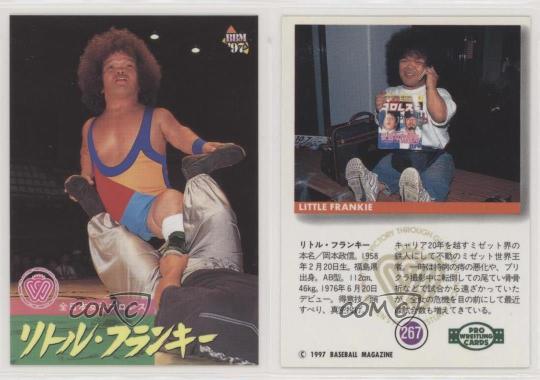
On the other hand, his successor Little Frankie (real name Masanobu Okamoto) had a very well-documented 10-year career, working for All-Japan, DDT and FMW. Two years into his wrestling career, he was hired to portray Little Godzilla in GODZILLA VS. SPACE GODZILLA (1994), essentially the same character as Machan's Minya in the rebooted continuity.
42. PAT ROACH

Another ring veteran with a long and storied career, Pat Roach enjoyed four decades as a mainstay on the British wrestling scene, stretching from 1960 until he retired in 1998 and holding the British World Championship in the mid-'80s. Nearly a decade into his grappling career, Roach was hired to play a small role in Kubrick's A CLOCKWORK ORANGE (1971) and spent the next thirty years working the two professions concurrently with pretty decent success. He ended up appearing in a number of notable films including three different Robert E. Howard adaptations (CONAN THE DESTROYER (1984), RED SONJA (1985) and KULL (1997), Harryhausen's CLASH OF THE TITANS (1981) and the James Bond vehicle NEVER SAY NEVER AGAIN (1983). But there would be two roles in particular that would imprint Roach in wider social awareness, the German Mechanic in RAIDERS OF THE LOST ARK (1981) and WILLOW (1988)

Roach's appearance in the first Indiana Jones film - he actually appeared in all three of the original trilogy in different roles - was brief but memorable, as his eager but ill-fated hulking mechanic spars with Indy for a few before eating an airplane propeller. It would prove memorable enough that his character received action figures, including a vintage Kenner release at the time of the film. Toward the end of the '80s, Roach would step before the camera again as General Kael for WILLOW, and while the film did not reach the heights of Lucas' previous STAR WARS, it was still marketed heavily and Kael's fearsome visage was plastered all over it.
41. MIKE LANE

Mike Lane may not be that well-known in either the wrestling or film worlds, but he definitely deserves a spot on this because, let's face it - how many wrestlers got to be villains on the 1966 Batman TV show? (Spoiler: There was at least one more, featured later on this list). Lane was a tall man - billed at 6'8" - and turned his size into a career, starting off as a circus act before getting into wrestling, where he was billed as Dick Hollbrook for a time before switching to Tarzan Mike. Throughout the 1950s, Lane worked mostly California promotions, battling the likes of Mad Dog Vachon, Hard Boiled Haggerty and Duke Keomuka.
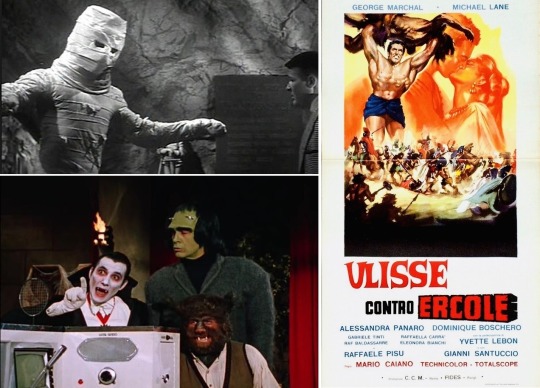
But not long after getting into wrestling, Lane's height landed him a role as a boxer in THE HARDER THEY FALL (1956), which was Humphrey Bogart's final film role. While still wrestling, Lane picked up a side gig as an actor, parlaying his frame into multiple roles as the Frankenstein monster (FRANKENSTEIN 1970 (1958) and the 1976 television show MONSTER SQUAD) and Hercules in one of the many peplum films made in Italy at the time. Oh, and he was a Batman villain. Sure, he was just one of the "goons," as Tallulah Bankhead's Black Widow was the main villain for the two-episode story, but Lane's goon was a rarity in that he got his own villain name: Daddy Long Legs. Mike would bring his wrestling career to an end at the start of the '60s, devoting more time to appearing in the likes of KOJAK, KNIGHT RIDER and THE MONKEES, though he apparently returned for one single match in 1985, facing Outlaw Ron Bass.
40. RUSS FRANCIS

Moving away from movies to sports, here's one that has some of you saying "Wait, I thought we weren't counting WWF appearances and everyone knows this guy was in the Wrestlemania 2 battle royal." Well, yes, that's true, but here's what's also true: Russ was something of a "ringer" for the match. Russ was the son of wrestling promoter Ed Francis and teamed with his brother Bill for a number of years in the mid-1970s (all while playing football at the same time), even winning the NWA Hawaii Tag titles.
39. ERNIE HOLMES
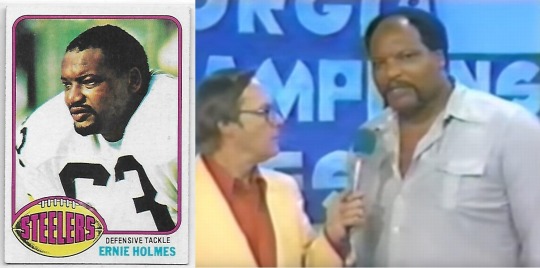
And Russ wasn't the only ringer on the football side of that WM2 battle royal. About five years before taking part in that spectacle, two-time Super Bowl winner Holmes had previously dabbled in the wrestling territories, working a little over a dozen matches for the Georgia territory (feuding mostly with Baron Von Raschke), a tag team match with Buck Robley against the Freebirds (Hayes & Gordy) in Mid-South and a few sporadic appearances at a smaller Texas territory.
38. OTIS SISTRUNK

From a Super Bowl-winning Steeler with ties to the Freebirds, we turn to a Super Bowl-winning Raider with ties to the Freebirds. A Pro Bowler, Sistrunk's time in professional wrestling was fairly short. After a one-shot for Mid-Atlantic against Big John Studd, Otis went to Georgia, where he was recruited by Michael Hayes to help him against Terry Gordy and Jimmy Snuka. The ad hoc pair ended up winning the tag titles, but the business proved not to be for Sistrunk, as he would suddenly vacate the title and retire from wrestling after half a dozen or so matches.
37. WOODY STRODE
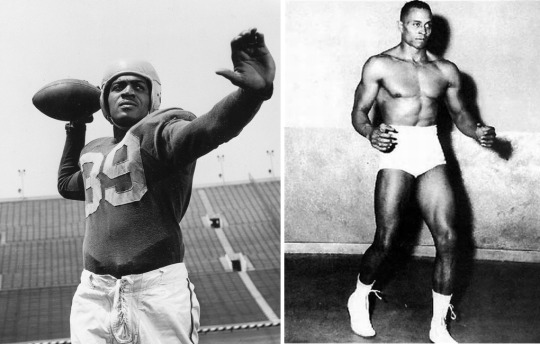
Few of the football players on this list are as legendary as Woody Strode. When the NFL finally allowed Black men to compete, Strode was one of two such men who broke the race barrier in 1946. Alongside a healthy film career (Woody was nominated for a Golden Globe for his role in SPARTACUS (1960)) that saw him appear in around a hundred roles in 55 years, Strode featured in Tarzan/jungle and Hercules/peplum movies, westerns, and was even a Batman villain at one point, as the Grand Mogul (told ya Mike Lane wasn't the only Bat-Villain on this list).
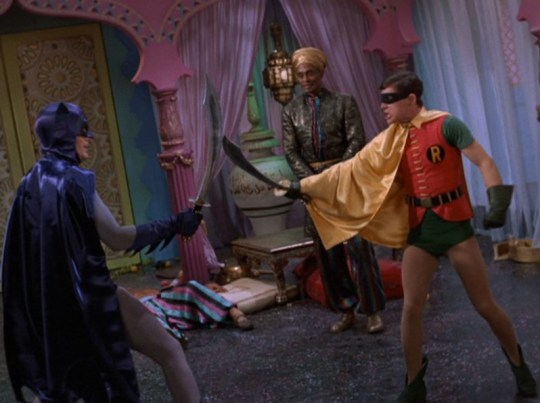
But before Woody ever played professional football, he was a pro wrestler. Strode first jumped into the squared circle in 1940, working the California area for a short time before his football career took off. Once touchdowns were in the past, Strode would again return to wrestling in 1949, spending the next eight years working the likes of Gorgeous George as he traveled everywhere from Hawaii to Canada. After a brief comeback half a decade later, Strode finally hung up the boots and focused on acting.
36. ALEX KARRAS
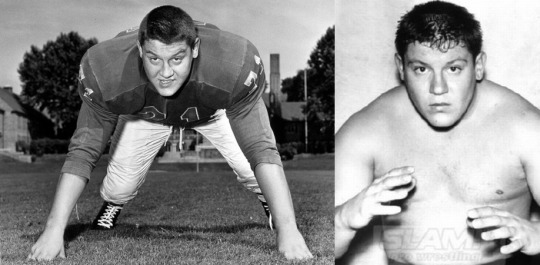
Few football players on this list had a more controversial career than four-time Pro Bowler Alex Karras. For about six months, Karras turned to pro wrestling between his college and NFL careers, having matches with the likes of Wilbur Snyder, Dick the Bruiser, the original Nicoli Volkoff, Don & Jackie Fargo, and Bronco Lubich. In the early '60s, Karras admitted to gambling on NFL matches, a serious no-no for an NFL player. With nothing else to do while serving out his suspension, Karras went back to his old grappling stomping grounds, joining the AWA for a losing effort against Dick the Bruiser before returning to the gridiron. Now, while a 4-time Pro Bowl player might be enough to get someone like Karras on the list, it's really what happened after both of his sports careers ended. See, Karras discovered he was only a pawn in the game of life.

Alex turned to acting, and in-between smaller roles in films like M*A*S*H (1974) and PORKY'S (1981) had two breakout roles that endeared him to millions. His supporting role of Mongo in 1974's BLAZING SADDLES and later starring with Emmanuel Lewis on the hit show WEBSTER (1983-87) as George Papadopolis. Oh, and he was the Hooded Fang in the children's cult classic JACOB TWO-TWO MEETS THE HOODED FANG (1978). Not bad for a guy that started off making some bad bets.
35. JACK DEMPSEY

While football is the most common sport one transitions from to wrestling, boxing isn't far behind it and some of the biggest names in the game have dabbled in wrestling as well. In the modern era, we have the likes of Mike Tyson, Muhammad Ali and Tyson Fury, but the legacy goes way back. In the 1920s, Jack Dempsey - while still World champion - would take part in public exhibitions with his friend Luigi Montagna, aka Bull Montana the wrestler to entertain crowds before his title matches. In 1925, the two fought at the Los Angeles Memorial Coliseum as part of a celebration for military athletes and personnel, with Dempsey tossing Bull out of the ring to win the match. After his heyday, Dempsey would do some referee work in wrestling, apparently reffing at least one match between Lou Thesz and Buddy Rogers, and by the 1940s, he would occasionally pop up on North Carolina wrestling cards in straight-but-semi-worked boxing matches.
34. JOE LOUIS

Dempsey was only a pioneer in the pugilist-to-wrestler field, and many World champions would follow. Joe Louis, whose title reign still holds the record for length, found himself in the same place as his boxing career drew to a close. Shortly after retiring from one ring, Louis stepped into a new ring in 1954, working across the Midwest, but his life as a grappler would be short-lived, as an injury in '56 led to his retiring from active competition as well. Joe would then become a referee before he returned to active wrestling in later '60s, usually as part of tag matches, and retire from the ring for good in the mid-70s.
33. JOE FRAZIER

Knocking out the boxing round of this list, Joe Frazier. The first man to defeat Ali, once Frazier was done in the ring (for a time, he attempt multiple comebacks), he found himself in the world of wrestling. While many are aware of his shots as referee for the Flair/Dusty match at the second Starrcade and as cornerman for Mr. T at Wrestlemania 2, Frazier had been part of wrestling for years prior. As early as 1979, he was reffing for Carlos Colon in Puerto Rico. He would put on the tights himself in April of 1984, having matches against Colon and Victor Jovica before refereeing a match between Colon and Bruiser Brody that same month (with the finish seeing Brody taking a punch from Frazier).
32. BABE RUTH

Few names on this list - or many lists, for that matter - are more legendary than the great Bambino, Babe Ruth. Still considered by many to be the greatest baseball player ever, Ruth remains an icon many decades later. After his days as a slugger were over (and even during them, according to the Bleacher Report), Ruth spent some time in 1945 as a celebrity referee in the Maine, Boston and Portland areas, and as pics suggest, would get more physical with the wrestlers than many refs of the era would.
31. TONYA HARDING
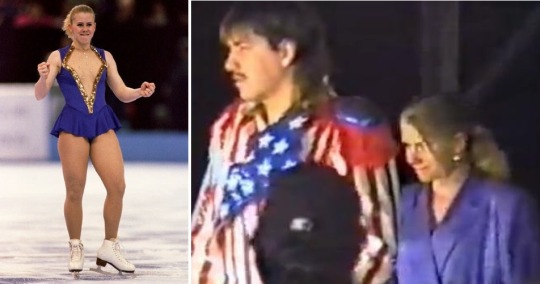
After finding herself exiled from figure skating after her husband orchestrated an attack on a fellow skater, Tonya Harding became a tabloid regular in the mid-'90s. Seeking to exploit her notoriety, wrestling promoters quickly began courting her. Weeks after the attack, the WWF made her an offer to appear at Wrestlemania X (she declined) and soon after, Takashi Matsunaga offered her $2 million to work for All-Japan, but for whatever (likely legal) reason, that did not pan out. That didn't stop wrestling from wooing the disgraced skater.

On June 24, 1994, Harding would make her wrestling debut in less grand fashion in Oregon, agreeing to appear on a bizarre show comprised of Portland-territory regulars and lucha libre stars, with even the press conference for that getting air time on CNN. For one night only, Harding was the manager of Los Gringos Locos (Eddy Guererro and Art Barr) and their trios partner Brian Cox, facing off against Blue Panther Jr, Perro Aguayo and Konnan. Things got really odd, as the promoters never had time to procure a manager's license for Harding, so after the ring introductions, she had to spend the match sitting in a chair halfway down the entrance aisle. That would be it for Harding's time in wrestling for over a decade, during which she found a new calling as a professional boxer. Around 2008, while competing for a boxing promotion in Arkansas, Harding was confronted in the ring by local wrestling personality Boss Campbell, who trash-talked the crowd and Tonya before she punched him out.
6 notes
·
View notes
Text















1944.
Camel Cigarettes presents the Jimmy Durante - Garry Moore Show.
7 notes
·
View notes
Text
Today's Feature Presentation
twitch_live
Showing an old Christmas Movie for the holidays starring Jimmy Durante and a stop motion squirrel named Rupert.
Join me on my Twitch Channel for a bit of holiday cheer.
#vtuber horror host#b-movies#envtuber#indie vtuber#alien vtuber#space boy vtuber#vtuber uprising#vtubers of tumblr#vtublr#vtubers are live#twitch.tv
2 notes
·
View notes
Text
LUCY & THE SUNDAY FUNNIES
A Look at the Comic Strips of the Lucyverse

Comic strips and comic books are part of pop culture history - just like Lucy - so it is natural that the two sometimes collided. Here are some examples of popular comics that went from the Sunday funny gage, to the Monday night tv fun!
DICK TRACY

Dick Tracy is an American comic strip featuring a tough and intelligent police detective created by Chester Gould. It made its debut on October 4, 1931 in the Detroit Mirror, and it was distributed by the Chicago Tribune New York News Syndicate. Dick Tracy has also been the hero in a number of films, two of which were released in 1947. From 1934 to 1948 "Dick Tracy" was also radio serial. Tracy was mainly heard about on Lucille Ball's radio show, "My Favorite Husband" (1948-1951).
"SECRETARIAL SCHOOL" (February 18, 1949) Liz begs the Blabbermouth on the party line to allow her to make a quick call.
LIZ: “Do you have to use the telephone?”
BLABBERMOUTH: “Whaddya expect me to use? A two-way wrist radio?”
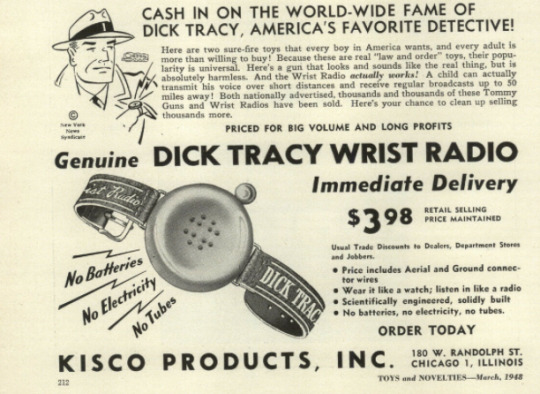
In 1946, Dick Tracy introduced a two-way wrist radio. In 1948, that cartoon item was brought to reality, along with a myriad of other Dick Tracy-themed toys.
"THE ANNIVERSARY PRESENTS" (May 13, 1949) Liz is positive that George will remember their anniversary. After dropping several hints, George still hasn’t said anything. Finally, he looks up from his newspaper with something to tell her.
GEORGE: “Dick Tracy found the jewels!”

On May 13, 1949, the daily Dick Tracy comic strip revealed that the missing jewels has been found. The case involved a character named Pear-Shape, who owned a weight loss business but was overweight himself. He conned an elderly widow out of the jewels and sold them to a fence.
"GETTING OLD" (May 20, 1949) Liz find a book she forgot to return to the library, long overdue. George wants to donate it to their tag sale, but Liz refuses to handle ‘hot’ merchandise. George sarcastically calls her Pear-Shape.
George is not referring to Liz's waistline, but to the character in the Dick Tracy comic strip named Pear-Shape Tone, who was part of the storyline from April to July 1949. He was a racketeer who would steal jewelry from his wealthier clients, then fence it to make a profit.
"LIZ IN THE HOSPITAL" (May 27, 1949) As George speeds toward the hospital a cop pulls them over. Liz thinks that if she gets arrested she can’t go to the hospital so she tells the officer that they are driving a stolen car. When George tries to interrupt, she calls him Pear-Shape to further reinforce her fake story of thievery.
Pear-Shape must have been quite popular in May 1949, because this is the third consecutive episode of “My Favorite Husband” where he is mentioned!
"LIZ AND GEORGE ARE HANDCUFFED" (December 30, 1949) George overhears Liz playing out a scene from Dick Tracy with little Tommy Wood from next door, who got a Dick Tracy outfit for Christmas and has been playing cops and robbers ever since. Liz says his sisters won’t play Tess Truehart to his Dick Tracy. George corrects her that she is now known as Tess Tracy, since Dick and Tess recently got married.
LIZ: “You mean I’ve been playing around with a married man?”
On December 25, 1949, just five days before this broadcast, Dick finally married his girlfriend, Tess Truehart.

Little Tommy ‘Tracy’ comes over to show ‘Pruneface’ Cooper (Liz) his badge, handcuffs, and finger print outfit.
LIZ: “Tommy, is it true that no two people in the whole world have the same fingerprints?”
TOMMY: “Nah, that’s a lot of bunk. I’ve already found three people who have exactly the same fingerprints; my daddy, Santa Claus, and the crook who broke into my piggy bank.”
"THE JIMMY DURANTE SHOW" (April 29, 1948) Lucille Ball guest stars in an episode where they take a magic carpet around the country to see how things might be different if women were captains of industry. In Paris, Illinois, they visit the second largest perfume factory in the country, owned by Hot Breath Houlihan.
DURANTE: “Now I know who set B.O. Plenty’s house on fire!”

B.O. Plenty was a character from Dick Tracy comic strip. In March 1948, his house mysteriously burned down and everyone feared the character was dead. Readers actually wrote to the newspaper begging Chester Gould not to kill off B.O. Plenty and Gravel Gertie!
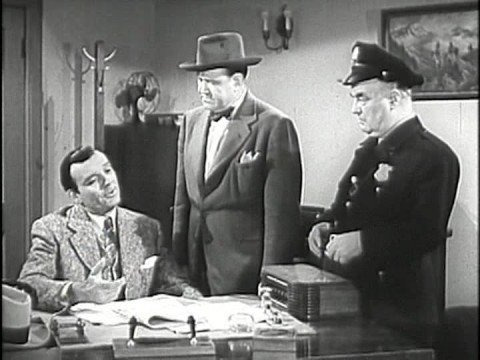
From 1950 to 1951, "Dick Tracy" was a television series, ending just a few months before "I Love Lucy" went on the air. Dick Elliott (right) made his television debut as Officer Murphy. He had done several films with Lucille Ball and appeared on "I Love Lucy" in two episodes. Likewise, Pierre Watkin played Police Chief Pat Patton. He had also done several films with Lucy and two episodes of "I Love Lucy."

Ten years later there was an animated series titled "Dick Tracy" featuring Lucille Ball alumni Jerry Hausner, Benny Rubin, and Mel Blanc.
In 1967 there was a pilot for a new live-action "Dick Tracy" series that went unsold. It featured Eve Plumb and Victor Buono, who later did episodes of "Here's Lucy," but were far more famous for other shows.
LI'L ABNER
Li'l Abner was a satirical comic strip that featured a fictional clan of hillbillies living in the mountain village of Dogpatch USA. Written and illustrated by Al Capp (1909–1979), the strip ran for 43 years, from August 13, 1934, through November 13, 1977. The strip inspired a 1956 Broadway musical that was filmed in 1959. Prior to that there was a non-musical film in 1940. A radio series was heard from 1939 to 1940.
"GEORGE ATTENDS A TEENAGE DANCE" (November 20, 1948) This episode of "My Favorite Husband" opens with Liz reading the morning papers over breakfast.
LIZ: “Who do you suppose got married?”
KATIE THE MAID: “Li’l Abner and Daisy Mae?”
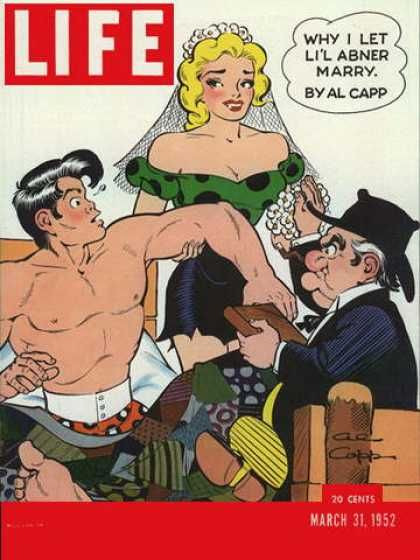
Almost from the start, Abner Yokum was being pursued for matrimony by Daisy Mae Scragg. The reading public found it quite a tease that the two were clearly destined to get together. They finally married in 1952, nearly four years after this broadcast. The event made the cover of LIFE Magazine.
"LIZ LEARNS TO DRIVE" (November 13, 1948) George reads about his old college girlfriend, Myra Ponsenby, in the morning paper. Liz is unenthusiastic.
LIZ: “What’s new in Lower Slobbovia?”

“Lower Slobbovia” was a term first used in 1946 by Capp to describe a place that was unenlightened and socially backward. The term entered popular culture when referring to any place hopelessly stuck in the past.
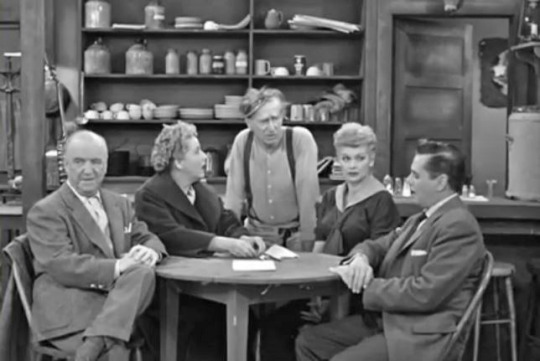
"FIRST STOP" (January 17, 1955) Fred Mertz calls the rundown Ohio roadside diner "Lower Slobbovia.”

In "Tennessee Ernie Visits" (May 3, 1954) Fred calls Cousin Ernie "Little Abner".
The Broadway musical and film adaptation starred Peter Palmer as the title character. Palmer played Brother Peter in Lucille Ball's failed NBC sitcom "Bungle Abbey" (1980). On Broadway, Daisy Mae was played by Edie Adams (aka Mrs. Ernie Kovacs), who played herself in the very last episode of "The Lucy-Desi Comedy Hour" (1960). The film also featured Lucy players William Lanteau, Alan Carney, Bern Hoffman, Bobby Jellison, and Torben Mayer.
The 1940 film featured Lucy's mentor Buster Keaton as Lonesome Polecat and Dick Elliott as Marryin' Sam. A new 1971 musical special featured Lucy alumni Carol Burnett, Ken Berry, Eddie Albert, and Donald O'Connor. In 1967, "Here's Lucy" director Coby Ruskin created a pilot for a "Li'l Abner" series that failed to sell.
LITTLE ORPHAN ANNIE
Little Orphan Annie was a daily comic strip created by Harold Gray and syndicated by the Tribune Media Services. It made its debut on August 5, 1924, in the New York Daily News. In 1930 it became one of the first comic strips adapted to radio, and attracted about 6 million fans before leaving the air in 1942. It was adapted to film in 1932 and 1938, and (like Li'l Abner) even became a Broadway musical. The success of the 1977 musical is credited with revitalizing the popularity of the franchise. The musical was filmed in 1982, 2014, and for television in 1999.
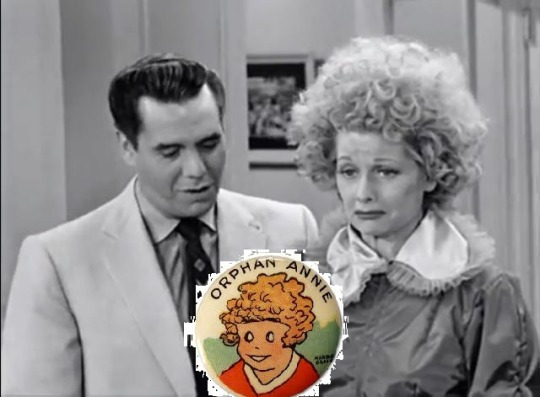
"LUCY WANTS NEW FURNITURE" (June 1, 1953) Lucy likens her over-permed hair to a chrysanthemum, while Fred calls her Little Orphan Annie.
Annie is generally depicted with a mass of red hair and a red dress with a white collar.
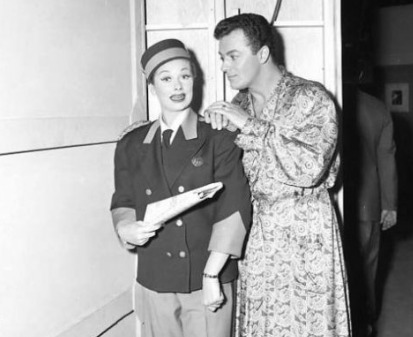
"THE STAR UPSTAIRS" (1955) Cornel Wilde is trying in vain to read a soaking wet newspaper thrown to him in the bathtub by Lucy disguised as a bellboy.
WILDE: “I thought President Eisenhower was playing golf with Little Orphan Annie.”
Eisenhower was famous for playing golf and Annie was famous on the comic pages, so it easy to see a mash-up of the two from a soggy paper.
"LUCY AND ART LINKLETTER" (January 10, 1966) Seeing Lucy’s wide-eyed look, Mr. Mooney tells her to "stop looking like an over-aged Orphan Annie.”
In the comic strip, Annie's eyes have no pupils!
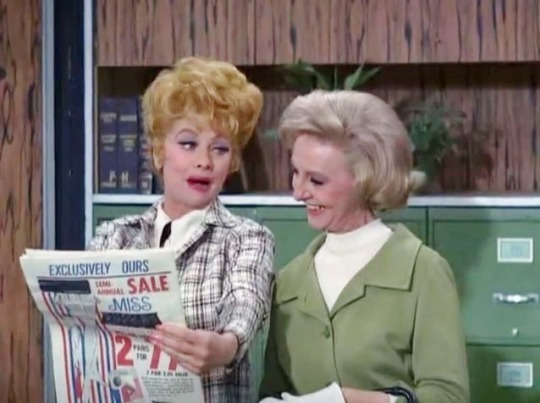
"LUCY GETS TRAPPED" (September 18, 1967) Lucy calls in sick, but goes shopping instead. When she's named Customer of the Year in a big celebration, she tries to hide the newspaper with her picture in it from Mr. Mooney. She tells him there's nothing new in the newspaper.
LUCY (about the news): "Oh, the temperature’s up, the stock market’s down, and Little Orphan Annie is lost again!”
During its 86 years of publication, Annie being lost or having disappeared was a frequent storyline. In fact, when the strip finally ceased publication in 2010, it ended with Daddy Warbucks "resigning himself to Miss Annie's being lost forever."
SUPERMAN

The Man of Steel was introduced to the world in comic book form in June 1938, created by Jerry Siegel and Joel Shuster. Beginning in January 1939, a daily comic strip appeared and a color Sunday version was added that November. Since then, the character, and characters from his world, has been seen in virtually every form of media, including, of course, television.
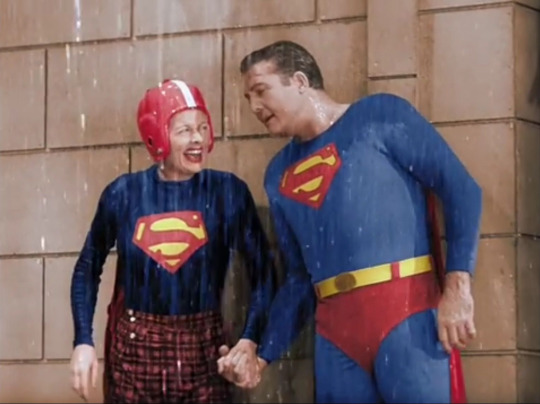
"LUCY AND SUPERMAN" (January 14, 1957) is considered one of television's first 'cross-over' shows. "The Adventures of Superman" aired from 1951 to 1958 in syndication, concurrent with "I Love Lucy". It starred George Reeves as Superman, a role he also plays on this episode of "I Love Lucy." While "Superman" made the transition to color in 1954, CBS kept "Lucy" in black and white for its entire run. Reeves is never mentioned by name in the dialogue or in the original credits, although it is pretty clear that Lucy and Ricky are recruiting "the actor who plays Superman" to entertain at Little Ricky's birthday party, not the superhero himself. Keith Thibodeaux (Little Ricky) later said that this was his very favorite episode. Because Desilu had obtained the license to use the actual Superman logo, they weren’t shy about using it! They even got permission to use the show’s theme music, composed by Leo Klatzkin.
Actors who were also seen on “Adventures of Superman” and their (characters) on “I Love Lucy”: Doris Singleton (Caroline Appleby), Elizabeth Patterson (Mrs. Trumbull), Tristram Coffin (Harry Munson), Herb Vigran (Jule / Al Sparks / Joe), Claude Akins (Himself aka ‘Giant Native’), Hayden Rorke (Mr. O’Brien), Phil Arnold (Harry Henderson / Man in Hotel Hallway), Milton Frome (Bill Henderson), Pierre Watkin (Mr. Dorrance), Dick Elliott (Tourist at Empire State Building / Yankee Stadium Spectator), Maurice Marsac (Maurice / Waiter), Frank J. Scannell (Buffo the Clown), Lou Krugman (Hollywood Director / Jewelry Salesman / Club Manager), Joi Lansing (Herself / Miss Low Neck), Larry Dobkin (Counterman / Waiter / Counterfeiter), Rolfe Sedan (Paris Chef), Eve McVeagh (Roberta the Hairdresser), Norman Varden (Mrs. Benson), Danni Sue Nolan (Mr. Reilly’s Secretary), Harry Cheshire (Sam Johnson), Ken Christy (Ken the Detective / Dock Agent), Robert Foulk (Brooklyn Policeman), Sid Melton (Jockey / Bellboy / Shorty), Bert Stevens (Tropicana Patron), Harold Miller (Theatre Patron / Ship Passenger), Hans Moebus (Man on Dock), Ernesto Molinari (Vineyard Boss), Jack Chefe (Bellhop / French Waiter), Bess Flowers (Tropicana Patron / Theatre Patron), and Monty O’Grady (Ship’s Passenger / Man at Airport).

Picking up Little Ricky’s toys, Lucy holds one of his “Superboy” comic books. It is the December 1956 issue (#53), hot off the presses during filming. Ironically, on the cover, Superman is looking at television! Even more ironically, inside the comic book was an ad titled “Draw Bob Hope”. Hope had just appeared on the season opener of “I Love Lucy.”
BATMAN

Batman was created by Bill Kane and Bill Finger in May 1939, just a year after Superman. As with Superman, there were numerous radio, film, and television adaptations of the characters, most notably a series starring Adam West that aired from 1966 to 1968.
Alas, there is no direct reference to the Caped Crusader in the Lucyverse. There are, however, plenty of indirect references due to the large number of actors who appeared on the television series who had also appeared with Lucy: Madge Blake, Cesar Romero, Van Johnson, Shelley Winters, Liberace, Tallulah Bankhead, Ethel Merman, Milton Berle, Rudy Vallee, Ida Lupino, Howard Duff, Stafford Repp, Victor Buono, Vincent Price, Edward Everett Horton, Vito Scotti, Norma Varden, Tristram Coffin, Ellen Corby, Sammy Davis Jr., Allen Jenkins, Art Linkletter, Alan Hale Jr., Jessyln Fax, Ben Welden, Dick Kallman, Alberto Morin, Bryan O'Byrne, and Larry Anthony.

Most notable among these is Madge Blake, who played Aunt Harriet on "Batman" as well as two characters on "I Love Lucy" and one on "The Lucy Show." She was also seen with Lucy and Desi in The Long, Long Trailer (1954). Coincidentally, she played Martha, a prospective new tenant in "Lucy and Superman" (see above). When she sees something outside the apartment window, her husband Herbert is concerned.
HERBERT: “Was it a bird?”
MARTHA: “No.”
HERBERT: “Was it a plane?”
MARTHA: “No.”
HERBERT: “Well, what was it, dear?”
MARTHA: “It was Superman!”
A 1949 film titled Batman and Robin featured Lucy performers Jack Chefe, Lyle Talbot, William Fawcett, and Phil Arnold.
DENNIS THE MENACE

Dennis the Menace, a comic strip centered around a mischievous but good natured young suburban boy, made its debut on March 12, 1951 syndicated in newspapers. Its success inspired comic books and (most famously) a television series that aired from 1959 to 1963.

"LUCY THE ROBOT" (February 28, 1966) Jay North, who played Dennis, guest-starred on a 1966 episode of "The Lucy Show" playing the 13 year-old nephew of Mr. Mooney (Gale Gordon). Lucy dresses as a toy soldier robot to divert him.
“You will keep that MENACE subdued for the next eight days!” ~ Mr. Mooney to Lucy about Wendell
During the final season of "Dennis", the long-suffering character of neighbor George Wilson was written out due to the death of actor Joseph Kearns. Kearns had played two characters on “I Love Lucy” - a psychiatrist in season one, and a theatre manager in season six. Gale Gordon was added to the cast as George’s brother, Henry.

When Lucille Ball was finally convinced to return to network television in 1962, she naturally wanted Gordon to join her, but he was unavailable due to his prior commitment to “Dennis the Menace” so Mrs. Carmichael’s put-upon banker was played by Charles Lane. Lane was also on “Dennis” as the recurring character of druggist Mr. Finch. He played the role six times before leaving for “Lucy”, his final episode airing just a day before his penultimate episode of “Lucy”!

When “Dennis” was canceled and Gordon was finally free, Ball wasted no time in hiring him and had Lane’s character was written out in order to make way for a new banker, Theodore Mooney. “Dennis the Menace” also had a character named Theodore Mooney - a police sergeant (George Cisar). He was often seen in the company of a woman named Lucy (Mrs. Lucy Elkins played by Irene Tedrow, and John Wilson (Gale Gordon).
Another cast member that "Lucy" and "Dennis" had in common was Danny, a cairn terrier who played Fred the dog on "I Love Lucy" and Freemont, Mr. Wilson's dog, on "Dennis the Menace." Danny was trained by Bill Blair and owned by Frank Inn, Hollywood's busiest animal actor supplier.
Besides Gordon, Lane, and Kearns, “Dennis” also featured “Lucy Show” and/or “I Love Lucy” alumni: Mary Wickes (Miss Cathcart), Edward Everett Horton (Uncle Ned), Kathryn Card (Mrs. Biddy), Parley Baer (Captain Blast), Elvia Allman (Edna), Tyler McVey (Mr. Carlson), Dub Taylor (Opie Swanson), Norman Leavitt (various roles), Bob Jellison (Announcer), Richard Reeves (Mr. Kelly), Lurene Tuttle (Mrs. Courtland), Nestor Paiva (Gamali), Jonathan Hole (Addison Brook), Stanley Adams (Jerry Richman), Willard Waterman (Otis Quigley), Harry Cheshire (Mr. Petry), Eve McVeagh (Mrs. Purcell), Harvey Korman (Bowers), Stafford Repp (Lt. Wheeler), Verna Felton (Aunt Emma), Madge Blake (Mrs. Porter), Ellen Corby (Miss Douglas), Eleanor Audley (Mrs. Pompton), and frequent extras Leoda Richards, Leon Alton, Olan Soule, Larry J. Blake, George DeNormand, and Monty O’Grady.
THE GUMPS
The Gumps is a comic strip about a middle-class family headed by hen-pecked husband Andy. It was created by Sidney Smith in 1917, launching a 42-year run in newspapers from February 12, 1917, until October 17, 1959, just six month before the last time America saw the Ricardos and Mertzes for the last time.
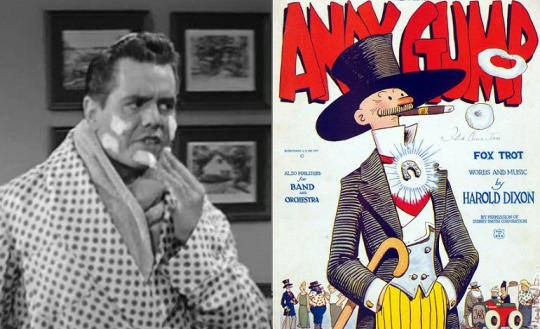
"The Adagio" (December 31, 1951) Ricky says “All this shaving is liable to wear my chin away,” to which Lucy replies “Okay, Andy Gump.”
The character had a bushy mustache but no lower jaw. Cartoonist Smith based him on real-life Andy Wheat who had his jaw removed after a tooth infection.
BUSTER BROWN
Buster Brown is a comic-strip character created in 1902 by Richard F. Outcault. Adopted as the mascot of the Brown Shoe Company in 1904, Buster Brown, along with Mary Jane, and with his dog Tige, became well known to the American public in the early-20th century. The character's name was used to describe a popular style of suit for young boys, the Buster Brown suit.

"THE ENGLISH TUTOR" (December 29, 1952) Lucy hires a grammar instructor so her new baby will grow up surrounded by well-spoken friends and family. Fred sarcastically shows up to the first session wearing a Buster Brown suit.
ETHEL: "All right, Buster Brown, go downstairs and get out of that silly outfit."

"THE RICARDOS CHANGE APARTMENTS" (May 18, 1953) To give Ricky the feeling their apartment is too small, Lucy fills the flat with toys, including a frog with a tongue that popped out when squeezed. This was actually a TV tie-in (one of the first) called Froggy the Gremlin. The character made its debut on radio’s “Buster Brown Gang” in 1944, which was brought to television in 1951 as “Smilin’ Ed’s Gang” with Froggy as a puppet and – occasionally – a life-sized costume character. In various formats, the program was seen from 1951 to 1960 (also on CBS) and featured "Lucy" performers June Foray, Vitto Scotti, Lou Krugman, Alan Reed, and Jerry Maren as Buster Brown.
BRENDA STARR, REPORTER
Brenda Starr is a comic strip started by Don Messick in 1940 about an adventurous and glamourous female reporter. The strip ended in 2011.

"LUCY BECOMES A REPORTER" (January 21, 1963) When Lucy takes a job as the editor of the Danfield Tribune's social column, Mr. Foley, the Tribune’s editor, sarcastically refers to Lucy as Brenda Starr.
Like Lucy, Brenda had red hair.
THE KATZENJAMMER KIDS
The Katzenjammer Kids was a comic strip created by German immigrant Rudolph Dirks which appeared from 1897 to 2006. Dirks was said to be the first to use 'thought balloons' in a comic strip.
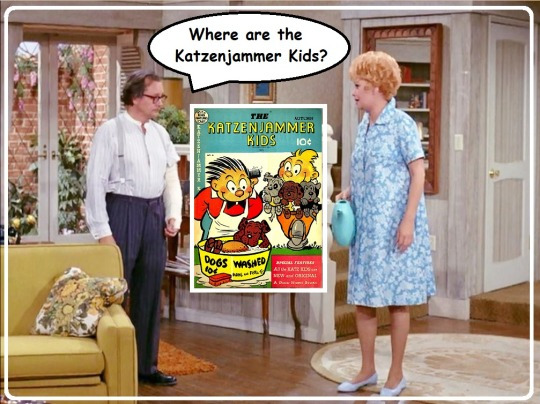
"LUCY AND THE DIAMOND CUTTER" (November 16, 1970) Wally Cox plays Gustav, a nervous diamond cutter who stays at the Carter home while waiting to cut an expensive gem. Gustav calls Kim and Craig “the Katzenjammer Kids.”
The line is humorous due to Cox's thick German accent.
BRINGING UP FATHER
"VIV VISITS LUCY" (1967) A hippie named Itchy (Les Brown Jr.) tells Viv he doesn't miss his parents because “that 'Maggie and Jiggs' action was pretty hard to take.” Maggie and Jiggs (or Jiggs and Maggie) was the colloquial name for a comic strip actually titled “Bringing Up Father.” It was created by George McManus and ran from 1913 to 2000. The strip presented the life of a nouveau-riche American family. It was translated to stage, radio, television and six films.

It is often forgotten that "I Love Lucy" was also a comic strip which appeared daily from 1952 until 1955. In fact, it was the comic strip that broke the news that Lucy Ricardo had given birth to a boy! These were then collected into "I Love Lucy" comic books. "The Lucy Show" was also a series of comic books, published by Gold Key from 1963.
#Little Orphan Annie#Lucille Ball#My Favorite Husband#I Love Lucy#The Lucy Show#Li'l Abner#Dick Tracy#batman#Brenda Starr#The Katzenjammer Kids#Dennis the Menace#Buster Brown#The Gumps#Here's Lucy#TV#Comic Strips#Comic Books#Batman#Superman#Superboy#Andy Gump#Bringing Up Father
6 notes
·
View notes
Text


After two seasons, NBC’s “The Jimmy Durante Show“ aired its last episode on June 23, 1956.
Pictured: Durante with guest Carmen Miranda in her final appearance.
30 notes
·
View notes